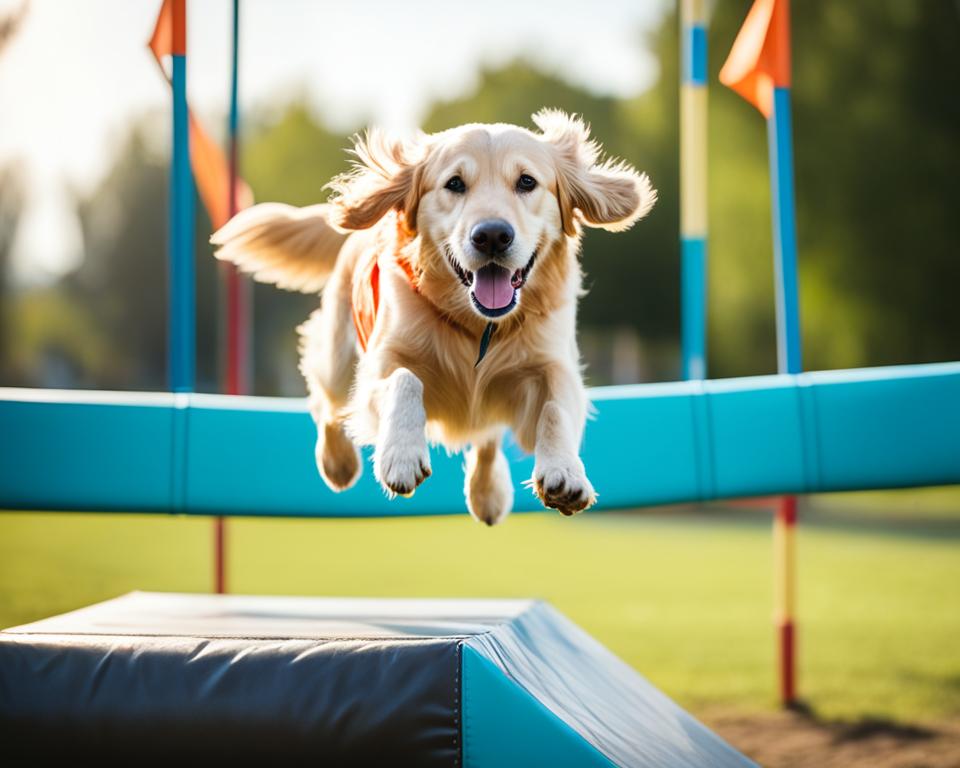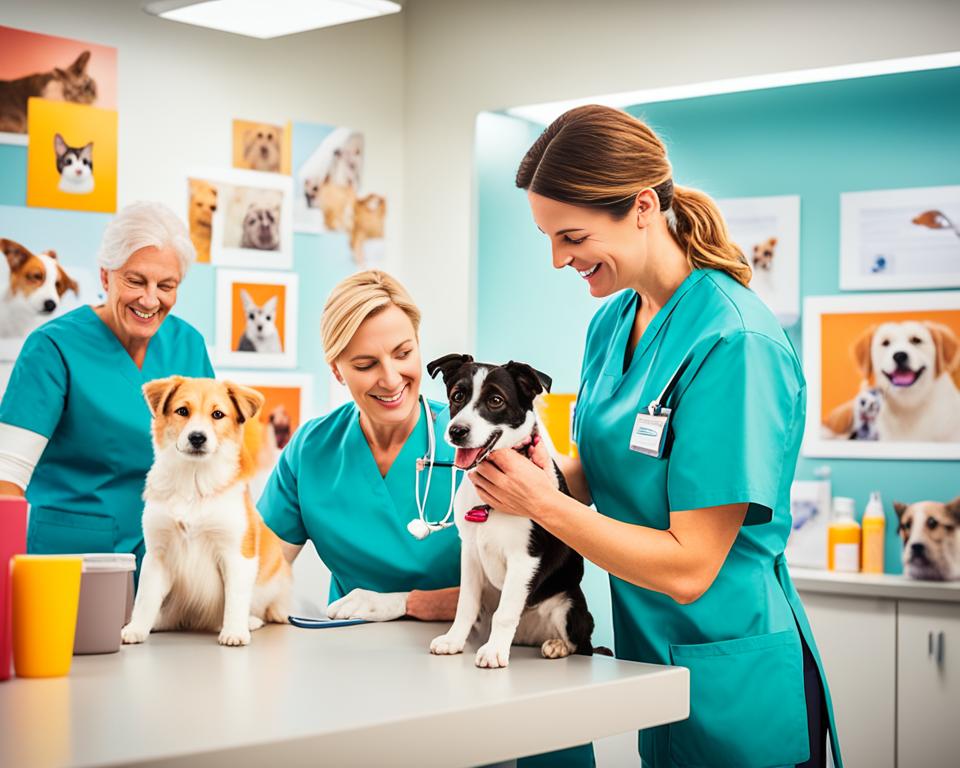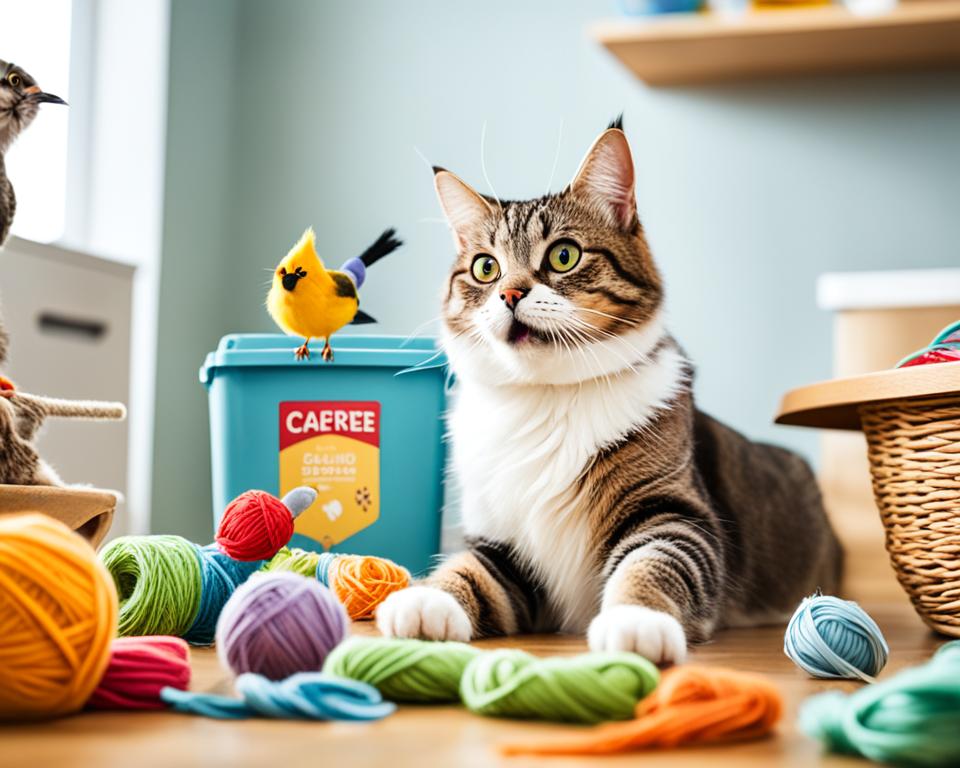Knowing how to take care of a pet is crucial for their happiness and health. As a pet owner, I’ve learned that it’s more than just feeding and walking them. It’s about creating a loving home and meeting all their needs.
Pet health is very important. I make sure they have fresh water at least twice a day. I also schedule yearly vet check-ups. For puppies, I take them out every hour or two. Older dogs need to go out more often.
Pet nutrition is key to their well-being. I work with my vet to pick the right food and avoid overfeeding. Exercise is also vital. Daily walks and playtime keep my pets fit and happy.
Grooming is a must for pet care. Regular brushing, baths, and nail trims keep them clean. I keep pet supplies like pet-specific toothpaste on hand for daily dental care. These steps help my pets stay healthy and happy.
Understanding Your Pet’s Basic Needs
As a pet owner, I know how important it is to give the best care to our furry friends. It’s key to know what your pet needs for their happiness and health. Let’s look at some key parts of pet care to make a loving and safe place for your pet.
Providing a Safe and Comfortable Home
Keeping your pet safe at home is very important. I make sure to remove dangers and give them cozy places to rest. Did you know that 1 in 3 pets might get lost? That’s why I suggest microchipping. Dogs with microchips are more likely to come home, and cats are 20 times more likely!
Establishing a Daily Routine
Pets do well with a routine. I set regular times for meals, walks, and play. This helps avoid behavior problems. For dogs, having a schedule is crucial. I make sure they join in family activities and have a place to chill, which helps their behavior.
Recognizing Signs of Stress or Illness
It’s important to watch your pet’s health closely. I look for changes in how much they move, eat, or how their fur looks. These can mean something’s wrong. Going to the vet regularly is key – I take my adult pets once a year and seniors twice a year. This helps find problems early.
| Pet Care Aspect | Frequency | Importance |
|---|---|---|
| Vet Check-ups (Adult) | Annually | Comprehensive health assessment |
| Vet Check-ups (Senior) | Biannually | More frequent monitoring for age-related issues |
| Litter Box Cleaning | Daily (1-2 times) | Keeps things clean and smells good |
| Nail Trimming | As needed | Helps prevent pain and discomfort |
Understanding your pet’s needs is a continuous process. By focusing on these basics, you’re building a strong foundation for a happy life with your pet.
Proper Nutrition: Fueling Your Pet’s Health
Feeding your pet is more than just filling a bowl. It’s about giving them the right food for health and happiness. Pet food is key to keeping them well.
Different pets need different foods based on their age, breed, and how active they are. Puppies need more protein for growth. Senior dogs may need less calorie-dense food. It’s important to pick food that fits your pet’s needs.

Good pet food should have real meat as the main ingredient. This gives your pet the proteins they need for strong muscles and organs. Whole grains and veggies give them steady energy. And don’t forget about healthy fats like omega-3s for a shiny coat and brain health.
A balanced diet is key to preventing issues like obesity, heart disease, and diabetes in pets.
Being consistent with pet nutrition is important. Stick to a regular feeding schedule and avoid giving them human food, which can be bad for them. Always give them fresh water and talk to your vet for advice on their diet.
| Nutrient | Function | Source in Pet Food |
|---|---|---|
| Protein | Muscle development | Meat, fish |
| Carbohydrates | Energy | Whole grains, vegetables |
| Fats | Skin and coat health | Fish oil, plant oils |
| Vitamins & Minerals | Immune support | Fruits, vegetables, supplements |
Remember, giving your pet the right food is an investment in their health. By choosing balanced, high-quality food, you’re helping them live a happy, active life.
How to Take Care of a Pet: A Comprehensive Guide
Caring for a pet is more than just feeding and housing them. It’s about making a caring space that keeps them healthy and builds a strong bond. Here are key pet care tips to help your furry friend live its best life.
Daily Care Essentials
Dogs need regular exercise. They should get 1-2 hours of activity each day. Huskies and German Shepherds need 2 hours, while Yorkshire Terriers are happy with 30 minutes.
Feeding them right is also key. Puppies from 8-12 weeks eat four times a day. Those 6 months to a year old eat twice a day.
Long-Term Health Considerations
Seeing the vet regularly keeps your pet healthy. Adult dogs should go once a year. Pet insurance can help with unexpected vet bills. Spaying or neutering by six months stops health problems and unwanted litters.
Building a Strong Bond with Your Pet
Being close to your pet is more than just playing together. Make sure they have a safe, cozy home. Hamsters need a big cage, and rabbits need lots of space to move around. Cats like homes with many rooms to explore. A happy pet means a stronger bond with you.
| Pet Type | Daily Exercise | Space Requirements |
|---|---|---|
| Dogs (large breeds) | 2 hours | Varies based on length |
| Dogs (small breeds) | 30 minutes | Varies based on length |
| Cats | Play sessions | Multiple rooms to explore |
| Hamsters | Exercise wheel | 39 x 20 inch cage |
| Rabbits | Free roam time | 10 x 6 x 3 feet space |
Follow these pet care tips to keep your pet healthy and build a lasting bond.
Regular Exercise: Keeping Your Pet Fit and Happy
Pet exercise is key for their health. It stops obesity and lowers the chance of diabetes and heart disease. It also makes pets happier and less stressed.
Indoor and Outdoor Activities for Dogs
Dogs need at least 30 minutes of fast walking every day. Swimming is good for dogs with joint issues. Agility training helps with coordination and stamina. Here are some dog exercises:
- Daily walks (30 minutes to 2 hours)
- Swimming sessions
- Agility courses
- Fetch or frisbee games
- Tug-of-war
Engaging Play Sessions for Cats
Cats do best with short play times all day. Interactive toys make them more active by 20%. Here are some ideas:
- Feather wands (10-15 minutes, several times daily)
- Laser pointer chase
- Climbing structures and scratching posts
- Puzzle feeders for mental stimulation

Exercise Needs for Small Pets
Small pets need exercise too! Here’s a quick guide for common small pets:
| Pet Type | Daily Exercise Needs | Recommended Activities |
|---|---|---|
| Hamsters | 2-3 hours | Running wheels, tunnels, exploration time |
| Guinea Pigs | 3-4 hours | Floor time, obstacle courses, gentle handling |
| Rabbits | 4-5 hours | Hopping, digging boxes, supervised outdoor time |
Regular pet activities keep pets healthy and strengthen your bond. Start these exercises today for a happier, healthier pet!
Grooming Essentials: Maintaining Your Pet’s Hygiene
Pet grooming is key to their health and looks. It’s more than just making them look good. It keeps them clean and healthy. Regular grooming helps me bond with my pets and catch health problems early.
Dogs with short hair need brushing once a week. Long-haired dogs need it more often to avoid mats. Cats should be combed twice a week to cut down on hairballs. Brushing spreads natural oils, keeping their coat shiny and less hairy.
Bathing is important for pet hygiene. I use special shampoo and warm water to protect their skin. How often depends on their lifestyle and fur type. Drying them well after a bath is key to avoid skin problems.
I trim my dog’s nails every month and my cat’s every few months. It keeps them comfortable and healthy. If you’re unsure, think about getting professional help.
Regular grooming lets me check on my pet’s health closely. It’s surprising what you learn about their well-being during these times.
Professional groomers are great for pets with special needs or who get anxious. They do deep ear cleaning, anal gland expression, and special cuts. Pets like Afghan Hounds or Poodles often need a pro’s touch.
| Grooming Task | Frequency | Benefits |
|---|---|---|
| Brushing | 1-7 times/week | Prevents matting, distributes oils |
| Bathing | As needed | Cleans coat, promotes skin health |
| Nail Trimming | Monthly | Prevents discomfort, maintains paw health |
| Teeth Cleaning | 2-3 times/week | Prevents gum disease |
Sticking to a grooming routine is vital for your pet’s health and cleanliness. It’s a big step in caring for them. It really makes a difference in their life.
Veterinary Care: Ensuring Your Pet’s Wellbeing
Keeping our furry friends healthy is very important. Regular vet visits are key to their health. I make sure to take my pets for check-ups and keep their shots current.
Scheduling Regular Check-ups
I visit the vet every six months for my pets. These visits help spot problems early. The vet checks my pets over, updates their shots, and answers my questions.
Importance of Vaccinations
Vaccines keep pets safe from serious diseases. I keep my pets’ shots current to protect them from rabies and distemper. The vet plans a vaccination schedule for my pet’s needs.

Dental Health for Pets
Dental care is often missed but it’s key for pet health. I brush my pet’s teeth often and get professional cleanings. Good dental care stops gum disease and other health problems.
“A pet owner should prioritize their pet’s health and wellbeing, including vet check-ups, vaccinations, and parasite prevention.”
By focusing on these areas, my pet stays happy and healthy. Regular vet visits, timely shots, and good dental care are key to great pet health.
Training and Socialization: Raising a Well-Behaved Pet
Pet training and socialization are vital for a well-behaved pet. Start early and use positive methods for best results. The time between 3-9 weeks for kittens and 3-14 weeks for puppies is key for social learning.
Consistent training shapes pet behavior. I train my dog daily with basic cues. This builds trust and strengthens our bond. For example, the “wait” cue helps in many situations, like at doors or during meals.
Socializing pets isn’t just for young ones. Older pets can learn to handle new situations well. Proper socialization lowers the risk of pets ending up in shelters due to behavior issues.
“A well-trained dog is a joy to live with and a credit to its owner.”
Here’s a breakdown of effective pet training techniques:
| Technique | Benefits | Examples |
|---|---|---|
| Positive Reinforcement | Encourages good behavior | Treats, praise, toys |
| Consistency | Establishes clear rules | Same commands, daily practice |
| Mental Stimulation | Prevents boredom, reduces destructive behavior | Hide treats, puzzle toys |
| Socialization | Builds confidence, reduces anxiety | Exposure to various people, animals, environments |
Pet training is a continuous journey. With patience and effort, you’ll have a well-behaved pet that brings joy.
Creating an Enriched Environment for Your Pet
A stimulating pet environment is key for your pet’s happiness. Pets need mental and emotional excitement to avoid bad behaviors from boredom and anxiety. Let’s look at how to make a fun space for your pet.
Selecting Appropriate Toys and Activities
Choosing the right toys is crucial. I suggest toys that make your pet think and act naturally. For dogs, puzzle toys help keep their minds sharp and cut down on barking. Cats like toys that mimic hunting, keeping them active.
Remember to change toys often to keep your pet interested.
Providing Mental Stimulation
Mental workouts are as important as physical ones. I’ve seen that scent games open a dog’s world through smell. For cats, food puzzles help fight boredom and aggression. Here are some fun activities for your pets:
- Hide treats for your pet to find
- Use food-dispensing toys instead of regular bowls
- Play classical music to reduce stress levels
- Set up an agility course for dogs
- Try clicker training for cats
Setting Up Pet-Friendly Spaces
Make special spots in your home for your pet to chill and play. For dogs, a dig pit lets them dig safely. Cats like scratching posts and high places to sit. Make sure your pet has cozy spots all over the house.
| Enrichment Type | Benefits | Examples |
|---|---|---|
| Social | Reduces anxiety, improves social skills | Playdates, family interactions |
| Occupational | Stimulates mentally and physically | Puzzle toys, agility courses |
| Sensory | Engages natural instincts | Scent games, new textures |
| Nutritional | Encourages natural foraging behaviors | Food puzzles, treat-dispensing toys |
With these enrichment ideas, you’ll make a fun pet environment. Your furry friend will be happy, healthy, and well-behaved.
Pet Safety: Protecting Your Furry Friend
Pet safety is very important to every pet owner. Keeping your home safe for pets is the first step. Did you know 80% of pets can get dehydrated in the heat? So, I make sure my pets have fresh water, especially in summer.
Some household items can harm pets. I keep toxic stuff, small objects, and harmful foods away from them. It’s scary that 65% of owners don’t know hot pavement can hurt their pets’ paws. I use pet-friendly wax or booties to protect my dog’s feet.
Never leave pets in cars, as it can cause heatstroke. The Humane Society says 90% of heatstroke cases in pets happen this way. I also limit their outdoor time to avoid sunburn and heatstroke.
Here’s a quick checklist I use for pet safety:
- Secure windows and balconies
- Use proper restraints in vehicles
- Keep pets microchipped and ID tags updated
- Have an emergency plan for natural disasters
Regular vet check-ups are key for pet health. They help catch problems early. By following these tips, we can keep our pets safe and healthy.
| Safety Measure | Percentage of Pet Owners Aware | Potential Risk |
|---|---|---|
| Dehydration Prevention | 20% | Heat-related illness |
| Hot Pavement Awareness | 35% | Paw burns |
| Heatstroke Prevention | 10% | Severe illness or death |
Understanding Pet Behavior: Strengthening Your Bond
Learning about pet behavior helps you connect better with your pet. Pet communication is more than just words. It’s important to know how they show feelings through their body language for good pet training.
Interpreting Body Language
Dogs and cats show their feelings in many ways. A wagging tail doesn’t always mean they’re happy. It’s important to see the full picture.
A dog with a relaxed body and a gentle wag of their tail is usually happy.
Addressing Common Behavioral Issues
Many pets act out because they’re bored or anxious. Regular exercise and fun activities can help. Consistency is key in training pets. Use short, clear commands – dogs like them better.
Positive Reinforcement Techniques
Reward-based training works best for good pet behavior. Treats, praise, and fun times are great rewards. Don’t use punishment, as it can stress them out and hurt your bond. Instead, guide them to better behaviors.
Learning about pet communication has changed how I connect with my pets. By understanding their likes and needs, our bond is stronger and more peaceful. Remember, every pet is different. Be patient and watch closely to understand them better.
Special Considerations for Different Pet Types
As a pet owner, I’ve learned that each pet type has unique needs. In the U.S., 68% of homes have pets. Dogs need regular exercise and to be social. I take my dog for walks and to the park every day.
Cats like to climb and scratch. I gave my cat a tree by the window for bird watching. It’s her favorite spot.
Small pets like hamsters and guinea pigs need special homes and bedding. When I had a guinea pig, I learned to give them lots of space and toys. Fish owners must check the water quality often and keep the tank right.
Birds need big cages and different foods. Reptiles need the right temperature and habitat for their health.
Knowing what each pet needs is important for their care. I prepare for a pet’s needs before bringing it home. This makes them happier and healthier. Whether it’s a dog needing training or a fish needing the right water, each pet is special.
By meeting their unique needs, we can make sure our pets live well with us.

